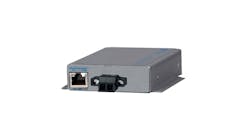Learn more on how to optimize with the Industrial Internet of Things in the series.
Based on the usual "if one is good, more will be better" reasoning, some users are starting to deploy multiple IIoT applications to monitor and manage larger groups of often far-flung applications and plants.
For example, Kennedy Industries in Wixom, Mich., reports its KI System Master (KISM) cloud-based SCADA platform manages data centers, redundant servers, firewalls, virtual private networks (VPN), access points and cybersecurity functions for more than 70 water/wastewater facilities in Michigan, and gives each client a customized dashboard that proactively alerts them about problems. KISM relies on PRTG network monitoring software from Paessler AG to monitor the utilities' infrastructures, including hundreds of pumps, valve controls and other IIoT-enabled devices that Kennedy implements for them.
Ben Manlongat, IT manager at Kennedy and VP and CTO of its KISM division, handles the company's infrastructure, and collaborates with its enterprise resource planning (ERP), operations and integration teams, while Mitchell Sobel, IT administrator at Kennedy, manages more than 100 endpoints and its core infrastructure. Their system's backend includes a network with multiple co-locations for backup, though they don't have time for manual monitoring.
Work the field network, minimize alarms
KISM’s datacenters, servers and device are networked via cellular to IoT monitoring points in the field. PRTG tracks how the KISM infrastructure and its client sites are running, which informs operators at the 70 utilities about their systems performance. IIoT devices that PRTG monitors include sensors for level, flow, pump status, valves, radar and physical security.
"Using PRTG for KISM lets us catch issues and fix them before the clients know about them, which prevents many problems," explains Manlongat. "We even implemented PRTG at both of our headquarters. With PRTG, as soon as I have a problem, there are 1,000-2,000 sensors that easily identify where the issue is. Using an app on my phone, I'm now solving problems in seconds instead of hours."
PRTG also monitors Kennedy's site-to-site VPN tunnels. Previously, it had two datacenters that required a continuous connection; one server in the first datacenter was the primary, while another server in the second datacenter acted as backup. “PRTG lets us monitor that connection, and if it fails, we get a notification to turn off the secondary backup server, which prevents client aggravation," adds Manlongat.
More recently, Sobel learned to stop nuisance alarms caused by monitoring its water/wastewater clients' public IP addresses. This used to trigger about 20 late-nights calls per month to restore downed client VPNs. PRTG added trends and insight about network data flows, which helped detect rogue devices, identify cyber-threats, and track down problems. He also monitors bandwidth of site-to-site mirroring to a co-location for Kennedy's backup files, and setup alerts for high data traffic volumes to limit costs.
"The biggest benefit of PRTG is it keeps an eye on the system 24/7, so we don't have to," says Sobel. "It monitors everything we care about."
Monitor conditions via the cloud
Christian Guegel, business development manager for IIoT at Paessler, reports it provides condition monitoring for any industry, usually at Layer 1 of the seven-layer Purdue Open System Interconnect (OSI) model, where the controls that are networked by OPC UA reside. "Our software easily integrates with users' applications, and auto-discovers the devices in the network," explains Guegel. "We do condition monitoring to make sure the infrastructure is up and running before data can be processed by public cloud providers like Microsoft Azure and Amazon Web Services (AWS)."
Guegel reports that IIoT supports connecting more machines and their data for central analytics. "The cloud allows massive amounts of data to be stored, and it provides the tools to deal with all of it, for example, using analytics or machine learning capabilities," says Guegel. “What we see here is a shift away from dedicated control hardware like PLCs and controllers towards specialized software that can run on any virtualized computer. Software industry paradigms and concepts transform manufacturing, so that classic IT and OT technologies meld into a new hybrid that takes the best of both worlds.”
Guegel adds that recent investments and product announcements by all major cloud providers reveal a visible strategy. "Analysts report that 50-80% of all data worldwide will be IIoT or machine-generated data by 2025," says Guegel "Since this is becoming the key business model, it's to the cloud vendors’ advantage to store and process all this data in their datacenters.
"IoT and edge technology is used to collect, store and process required data. Cloud technology is used to leverage almost infinite computing power and machine learning. As a result, service and maintenance of machines can be optimized, based on failure predictions, leverage detailed health status information and more."
Learning from partners
Because Paessler concentrates on monitoring technology, Guegel reports that it works with numerous partners focused on professional services and cybersecurity, who can define key performance indicators (KPI) and baselines that will direct the most useful ways to apply its PRTG software. "Once we have an asset inventory and baseline, we can begin to look for unusual behavior, which interfaces need to be fixed, where are potential bottlenecks regarding bandwidth, or what new communications are needed for new or upcoming traffic," says Guegel. "We have to learn what each user needs first, determine what's preventing them from getting there, and also make certain they have enough plant-floor monitoring before they go to the cloud. We also rely on our partners to cover these issues, and determine where potential security issues are when connecting OT to the IT, and take actions like micro-segmented networks to make their solutions cyber-secure."
Guegel adds that, to support and optimize virtualized, cloud-based, IIoT-enabled and mobile applications, users need a vendor-agnostic, holistic monitoring tool to ensure all devices are available, the underlying infrastructure is capable of handling the traffic, and there is no packet loss. Other insights gained could be unusual traffic detection, status updates on critical services, and data from security patches. From that, the next steps with regard to the OSI model would be to implement a application monitoring and integrate the utilized cloud services in the monitoring.
[sidebar id=2]
"Looking to the future, we will be faced with Industry 5.0, fully automated factories, and will need to ensure a steady quality process alongside the lifecycle of a machine or assets by having a constant data stream from the machine in operation," says Guegel. "There will be a shift in the working environment toward a safer and more and design-oriented workspace. This will create higher value jobs than before because a fully automated or dark factory only needs minimal human interaction, which frees up resources for design processes."






